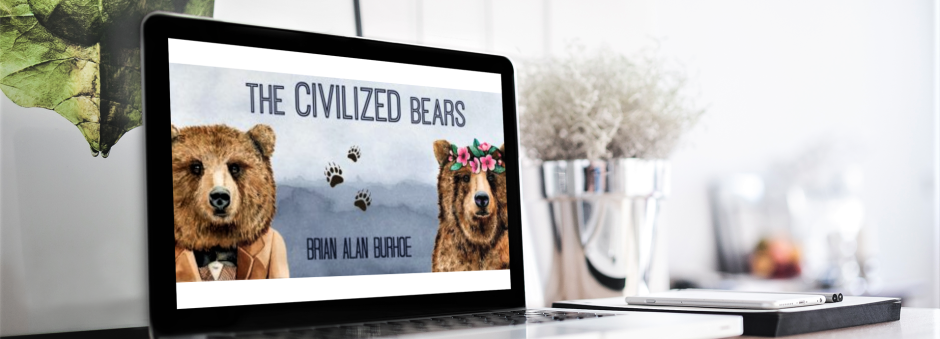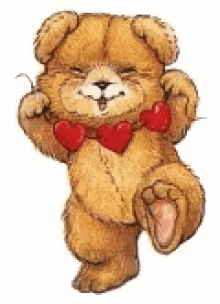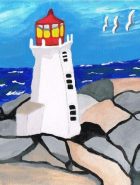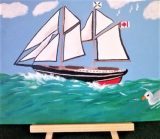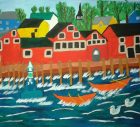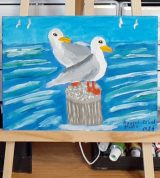Teddy Bears in History.
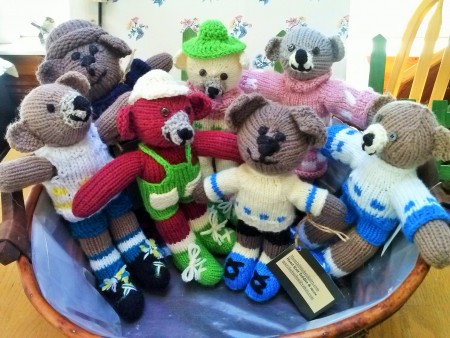
“A Basket of Teddy Bears” Compliments of Mary Lee at “The Urban Sloth Shop” See THE URBAN SLOTH SHOP – Crochet plant hangers and more
Queen Elizabeth celebrated her Diamond Jubilee with an assortment of mementos. These including tea towels, cushions and coasters as well as commemorative medals, coins and postage stamps. But Her Highness’s personal faves were the teddy bears.
There’s the Prince Charles limited production of £175 mohair Teddies. Just 250 were produced “In celebration of Her Majesty Queen Elizabeth II’s Diamond Jubilee.”
A popular collectible is the the Queen Elizabeth Collectible Teddy Bear, complete with Royal Crown sweater.
And the Queen Elizabeth II Teddy Bear is just the latest in a history that goes back over a century.
In fact, 111 years!
Here, with the help of Angeline, Ted and Devinder — friends, contributors and just plain ol’ good folks — is a look at our beloved Teddies, including the answer to the question “What is the most expensive Teddy Bear of all time?”
“Just knowing that your teddy bear is home waiting at the day’s end makes each day happier.” – Ted Menten
“I grew up in the spotlight. At night, my teddy bear let me be me.” – Patty Duke
The History Of The Teddy Bear
When were teddy bears invented?
“Okay, I’ll take the pink one with the torn ear.” The guy behind the counter scratches his neck, “Are you being serious?” Her face is stoic, “Absolutely. I never kid about teddy bears.” – Jessica Sorensen
It’s hard to imagine a world of stuffed animals without teddy bears.
They are a staple item of every toy collection. Oddly enough, the teddy bear did not develop simply as a stuffed version of a real bear. In fact, the teddy bear has only been around since the early years of the twentieth century.
According to most sources, the teddy bear first surfaced in both the United States and Germany in 1902. Popular accounts of the bear’s initial appearance in North America starts with a cartoon drawn by Clifford Berryman, called “Drawing the Line in Mississippi”.
The comic showed then-President Teddy Roosevelt refusing to shoot a small, cuddly-looking bear.
As legend states, Roosevelt had visited Mississippi to assist in a border dispute and during the trip, was taken bear hunting. Berryman was inspired to create the cartoon, displaying a recount of Roosevelt’s failed hunting experience and his attempt to play mediator.
The cartoon appeared in The Washington Post in 1902 and was an instant hit with readers. Leading to its eventual publication nationwide. Even Brooklyn-based Morris and Rose Michtom were motivated to design a stuffed animal that reflected the drawing, calling it ‘Teddy’s Bear”.
The Michtoms placed the bear in their store window and its popularity grew so quickly that, in conjunction with the Butler Brothers, they helped to establish the Ideal Novelty and Toy Company. The first American manufacturer dedicated to the production of teddy bears.
During the same time, Margarete Steiff and her nephew Richard Steiff were involved in the stuffed toy business in Germany. Ironically, Richard created a new stuffed animal design that featured a softer-looking, cuddly bear — similar to the Michtom’s.
Today, it’s easy for designers and developers to research toy ideas and determine whether or not something has been done already.
But in the early twentieth century, it was very likely that neither designer was aware of the progress of the other.
The following year, the Steiffs unveiled their first bear, “Bear 55 PB”, at a toy fair. An American toy buyer saw the bear and was instantly intrigued, since the teddy bear fad was sweeping his home country at the time.
In just four years after the creation of the first teddy bear, its popularity grew incredibly. Teddy bears were featured on home products and collectibles, magazines were produced, and songs were developed in honour of the newest bear craze.
As we all know, teddy bears were a hit with children, who revelled in the appeal and gentleness of the teddy bear as we know it today. For over a century, Teddy bears have been just as beloved by boys as girls.
From a President to a Queen, the Teddy Bear remains beloved, much more than a Toy!
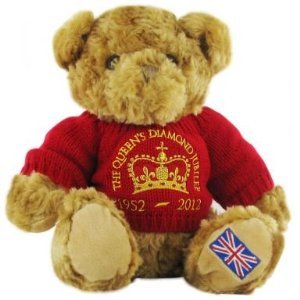
Queen Elizabeth Jubilee Teddy Bear
Teddy Bears, Stuffed Bears & History
How was the teddy bear invented?
“A bedroom without a Teddy is like a face without a smile.” – Gil Davies
When the teddy bear was first created by Margarete Steiff in 1902, the initial design was based upon the grizzly bear. And also based on the widespread news story of President Teddy Roosevelt sparing a young bear on a hunting trip.
Since that time, manufactures have drawn on other kinds of bears for inspiration in creating stuffed bears. In particular the American black bear, the polar bear, and the panda.
Like their teddy bear ‘cousin’s,’ stuffed bears are extremely popular plush toys. Bears are a familiar, if not relatable animal to children as they can often be seen in zoos and on television. Not to forget the countless book and movies where bears are also featured.
For children that live in places inhabited by bears, they may even be lucky enough to see them in their own backyard. It’s through their visual connections, that children are so interested in stuffed bears. While they likely have a teddy bear or two, eventually they may request having stuffed bears added to their growing inventory of plush toys.
There are eight species of bear of which toy manufactures can draw upon in creating stuffed bears.
Some are more well known than others; there is the Sloth bear, the American black bear, the Asiatic bear, the Grizzly or Brown bear, the Giant panda, the Polar bear, the Andean or Spectacled bear, and the Sun bear.
Bears began evolving over 40 million years ago. Fossils of what is known as the first “true bear” (Ursavus elemensis) have been found in what was once sub-tropical Europe. These fossils reveal an animal that was the size of a small dog. And it had combined characteristics that blended the traits of both a dog and a bear. Modern bears as we know them today, are all descendants of Ursavus elemensis.
Interestingly, the polar bear is not quite as old as other species of bear. It’s believed to have descended from the European cave bear which managed to survive two ice ages before becoming extinct. From the cave bear, the brown bear evolved, which eventually evolved to the polar bear some 20,000 years ago.
It’s no wonder children and adults alike are so enchanted by stuffed bears – the species has a long and varied history. It doesn’t hurt that like the real thing, stuffed bears are extremely soft and roly-poly which makes them ‘targets’ for lots of hugs.
All eight species of bear look equally huggable though for obvious reasons, the only way anyone will ever have the opportunity to hug a bear is if it comes in plush form.
Who Are The World’s Most Famous Real Life Bears? SEE Famous Bears – From Gentle Ben to Brutus Bear
Teddy Bears, Polar Bear Stuffed Animals & Facts
“Long before I grew up, my Teddy bear taught me what love really meant: being there when you’re needed.” – Jim Nelson
Like most soft toys, a polar bear stuffed animal is special. Not only does it represent the real thing, but it’s one of those plush toys that is super soft and cuddly. Everything you would expect in a soft toy. While a polar bear stuffed animal can be purchased as big or as small as you would like, better to lean toward the ones that are as over-sized as possible given they’re more like the real deal.
Polar bears are the world’s largest land predators. They evolved some 200,000 years ago from ancestors of the brown bear. They can be found living in Alaska, Canada, Russia, Greenland and Norway. Males range in size from 775 to more than 1,500 pounds while females are smaller topping out at 550 pounds.
There are various myths and misconceptions about polar bears that have been debunked by biologists who have studied polar bears for thousands of years; among native hunters, there is a legend that says polar bears cover their black noses while they lie in wait for their preferred food, seals. This type of behavior has never been seen by scientists. Another myth refers to the fact that the polar bear is a left-pawed animal.
However, when having been observed by scientists, no discernible preference has been noticed – they use their right and left paws equally. When killing their prey, polar bears do no use tools such as blocks of ice. The idea that they do [use tools], may have come from the fact that when unsuccessful in catching their food, an angry polar bear may kick the snow, throw chunks of ice, or even slap the ground.
Contrary to what many people think, polar bears only live in the Arctic in the areas that surround the North Pole, not in Antarctica which surrounds the South Pole. Because penguins and polar bears are often seen in pictures together, some believe they live in both places, but that could never happen.
A polar bear’s hair is not actually white – it just looks like it is.
Their fur is dense with an undercoat that helps insulate them from the cold. On top, their hair is of various lengths. Their hair is pigment-free and transparent which reflects visible light much in the same way it happens with ice and snow.
When they are in sunlight, and clean, a polar bear looks its whitest, but before they molt in the spring, the oil that gets on them from eating seals makes them look yellow. In 1979, a polar bear living at the San Diego Zoo turned green after algae in its hollow hair shafts grew.
The bear was not harmed and a zoo veterinarian restored the bears coat color by killing off the algae with a solution containing salt. A polar bears skin is actually black and under it is a very thick layer of blubber that can be as much as 4.5 inches thick. Polar bears hardly suffer any heat loss due to their fur and blubber insulation. In fact, when adult males run too quickly, they overheat.
With the availability of floppy polar bear stuffed animals, why would you even opt for any other kind? A floppy polar bear stuffed animal is one that can be made to sit up or lie down, both on its stomach or its back. And, this is a type of polar bear plush that is absolutely ideal for snuggling up with given it can practically wrap itself around you with its soft and floppy arms.
Life Size Plush and Teddy Bears After The War & The Steiff Teddy Bear
“My Teddy was there when I had no friends to play with, no one to talk to, no one to share my little woes or my big joys. He looked constant and was constant. He never aged, no matter how tattered he became. His smell was the smell of my years as a boy, and he alone knew everything. Now, when I see him on the shelf, he is like my flesh and my soul – older, worn, but still full of happiness.” – Robert Kunciov
With life size plush toys, a whole new way to play is immediately opened up for a child; no more pretending a lion or tiger is about to pounce in their make-believe jungle, but rather, they can have a soft toy that is almost as big as the real thing.
With toy bears that are 7.5 feet in length or giraffes that are 4.5 feet in height, life size plush enables a child to bring the real animal to ‘life,’ all in the comfort of their own home.
The economy in Germany was nothing short of a disaster after the country’s defeat in the war in 1918. With the Treaty of Versailles in place as of June 28, 1919, the territory was given up to Poland, Belgium, France, and Czechoslovakia. Under the newly formed League of Nations, all German colonies were given to the Allied Powers to administer which meant that the former German markets were much smaller than they were before.
It was during this newly created environment that the once lauded German teddy bear industry that had become lost to British manufacturers during the war, was able to bounce back.
The original Steiff teddy bears (which were the first teddy’s ever created) were made with mohair, but after the war it was very hard to come by in Germany.
In order to resume the production of teddy bears, other types of materials had to be found. The creator of the Steiff company, Margarete Steiff decided to use a cellulose plush which was made from nettle fibres. This particular bear was called ‘Brennessel Bear,’ and it was quite uncomfortable to hold since the fibers it was made from were very coarse.
Between 1919 and 1921, a total of 19,556 of these bears were produced and today they are highly valued by collectors because of their novelty value.
After the war, Steiff also returned to using boot-button eyes on their teddy bears but as soon as they could get glass eyes again (which is what their original bears’ eyes were made of), they were used universally. Most of the teddy’s from the early 1920s had clear glass eyes with backs that were painted brown and black pupils.
The classic teddy bear Steiff was known for, stayed very close to its 1905 design — a bear that had long arms, large feet with narrow ankles, a humped back and a protruding muzzle.
In 1921, Steiff introduced kapok stuffing and every bear from then on was lighter and fatter than before. In the same year, a conveyor belt system was introduced in the Steiff company which ultimately sped up production, but all the work on the soft toys was still done by hand (as it is today).
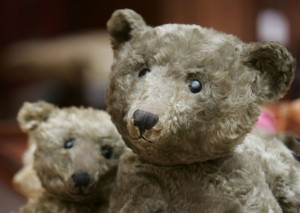
After the horror of the war, peoples’ spirits needed lifting and Steiff brilliantly read the international mood just right.
In the 1920s, they introduced a variety of cheerful, lively bears that couldn’t help but bring a smile to the lips of all who owned them.
Some of these teddy’s were dressed (including one called ‘Teddybu’ which was a classic bear that was white, golden, or dark brown) in a vest that was full of color. Other teddy bears had brightly colored fur – Teddy Rose – a pink, long-haired bear that was available in 1925.
One of Steiff’s most popular novelty bears was Teddy Clown which was introduced in 1926. It was available in 11 sizes that ranged from 9 inches to 45 inches and wore a distinguishable white Pierrot’s hat and ruff around its neck.
Petsy was another teddy bear introduced around the same time as Teddy Clown and it stood out because of its blue eyes and pink-red embroidered nose. Petsy was ‘blessed’ with large ears and with the use of an internal wire frame, could be moved around into different positions. Ten different sizes of Petsy were released in addition to a glove puppet and some that were on a wheeled chassis.
Life Size Teddy Bears
Just imagine the endless hours of fun that could be had with a life size plush teddy bear. Any child would fall all over themselves with joy after setting their sights on something so marvellous. If you’re in the market for the next gift to give for a special occasion, look no further than life size plush.
For years, Steiff identified its Teddies and other soft toys with a distinctive logo’d ear button, although it recently lost its trademark protection.
The General Court in Luxembourg has ruled that trademark protection can’t be granted because “buttoning the label to the soft toy’s ear lacks a ‘distinctive character’ and doesn’t in itself enable average consumers to recognize the product’s origin.”
“The ruling deals a blow to the German high-end manufacturer,” reported AP, “which sought better protection from competitors selling cheaper soft toys with similar ear buttons.
Who Are The World’s Most Famous Make-Believe & Story Bears? SEE Bears in World Literature and Other Stories
Life Size Stuffed Animals and Teddy Bears Designed by Women
“A Teddy bear is your childhood wrapped up in faded yellow fur, and as such, he commands affection long after he is outgrown.” – Pam Brown
Life size stuffed animals are exactly what you think they are: soft toys that are big as the real thing. Just imagine a plush black bear that’s 7.5 feet long and as wide as a queen sized bed — from nose to tail, the real thing can reach lengths of 7 feet. If it’s authenticity you’re looking for in your soft toys, you can have it with life size stuffed animals.
In the first half of the 20th century, there were many women (designers, managers, and owners) that had a direct influence on the industry making Teddy Bears.
This, at a time, when in Britain women over thirty had just been given the right to vote (in 1918). While the careful work and dexterity of women had always been of great value in both the textile and clothing industries, very few of them had ever reached the upper levels of management.
In the years following World War I, there was a shortage of men. Many of them had been killed or injured on the battlefield. With this, combined with the fact that the teddy bear industry was a relatively new one, there was an overall lack of tradition. This gave women opportunities they had never had before.
Norah Wellings began her career at the Chad Valley toy company designing soft toys. She stayed in that same position from 1919 to 1926. Then she left to set up her own factory in Wellington, Shropshire (England). It was called the Victoria Toy Works. Norah’s main focus was on cloth dolls but in her range of toys, she did include some teddy bears.
Norah Wellings’s teddy bears were very unique and a little out of the ordinary. They had more in common with the dolls she made than they did with traditional teddy’s. They often had no joints, were dressed, and had cloth bodies. Her brother was very heavily involved in the business and when he died in 1959, Nora decided to retire.
E.M. Daniels was another women in the teddy bear business. While she had far less experience that Norah Wellings, she did work for six months with different established toymakers before opening her own company in 1914. It was called Jungle Toys.
While E.M. started out with just two employees, by 1919, she had 15 people working for her. All making Teddy Bears.
Soon, she was shipping teddies worldwide. Daniels’ teddy bear designs played on its cute looks. Something that was evident in her Bingo Bear (a koala that was launched in 1928 when it was believed koala’s were part of the bear family).
In the 1930s, two women (whose names are unknown), set up a soft toy company called Pixie Toys. One of Norah Wellings’ former employees, Elizabeth Simmonds, joined Pixie as a designer. It was her contributions which had a major effect on the way in which Pixie bears developed. They share quite a few characteristics of some other famous teddy’s made by British companies Merrythought and Farnell. These included webbed-paw claws.
Elizabeth Simmonds went on to buy Pixie Toys from the founders in the late 1930s. When the demand for toys fell both during and after World War I, in 1955, a takeover of the company took place. The new ownership only managed to last seven years and the company closed its doors in 1962.
When it comes to life sized stuffed animals, teddy bears can also be found ‘living’ in this world.
While they don’t look much like the bears first created by the influential women of the teddy industry, that should make no difference in choosing one. Choosing any life size stuffed animal, for that matter, should be an easy decision.
Teddy Bears A to Z: A Teddy Bear Alphabet – Teddy Bears in 26 Letters
“To a child, Teddy is a bridge between a human and an animal. He doesn’t mind being dressed in ridiculous hats, or even being read to. You can blame him for anything, and he won’t deny it. His marvellous face expresses anything a child wants to feel or hear.” – Peter Bull
Teddy Bears A to Z:
Alpaca: A comfortable shiny fleece extremely prized for covering collectible bears. The fleece comes from alpacas that are native to the South American areas of Ecuador, southern Peru, the northern regions of Bolivia and Chile. Alpacas aren’t hurt when their fleece is sheared, and their wool is hypoallergenic.
Baloo: Who can’t forget Baloo singing “Look for the bare necessities. The simple bare necessities…”? From Kipling’s original JUNGLE BOOK (1894) to Disney’s cheerful movie version in 1967, “the sleepy brown bear” named Baloo has charmed his way into our memories. The first Disney Baloo teddy bear was released with the movie — since then, a number of stuffed Baloos have been released, including talking, singing versions. “Forget about your worries and your strife…”
Cotter Pins: An ingenious invention that makes it possible to produce jointed stuffed toys.
Dean’s: A popular toy production company in the United kingdom. They’ve been making classic Teddy Bears since 1903.
Excelsior: The type of wood shavings originally employed as stuffing content for bears and other toys.
Felt: Felted bears are built by matting unspun wool, using a process known as needle felting. Or they can be sewn from all set felted material.
Growler: The mechanism that gives some teddy bears their growl.
Hugs: The #1 benefit of teddy bears!
“Winnie-the-Pooh to Ted.”
Inspiration: Teddy bears have inspired such beloved literary, television and motion picture characters from Winnie-the-Pooh to Ted. Other movie Teddy Bears include Lots-O’-Huggin Bear (Toy Story 3), Bedtime Bear (The Care Bear Movie), Fozzy (The Muppet Movie) and Teddy (A.I. Artificial Intelligence).
Jointed: Teddy bears with movable arms, legs and neck.
Knitted Bears: No sooner had the Teddy Bear made its appearance than crafters began hand knitting their own bears. There’s been a renewed interest in collecting knitted bears, the most popular being in the traditional design (known also as Heirloom Bears) with each one being one-of-a kind, not made from an established pattern. Miniature teddies with hand-knitted clothing are especially trendy.
Little Bear: A character created by Else Holmelund Minarek and illustrated by Maurice Sendak in a popular series of five books. There have been a number of Little Bear toys made, including a talking, laughing version.
Mohair: A favoured yarn or fabric for collectible bears initially produced from the fleece of the angora goat. The USA and South Africa are the key producers of mohair materials.
Nanook: The Inuit name for the Polar Bear, who is central to Inuit mythology, artistry and survival. The Inuit of the Far North, including Canada, continue to produce a wide range of Polar Bear carvings, paintings and toys. White teddy bears have their own fans.
“Antique Teddy Bears.”
Older: Older teddy bears are classified as “Antique” if they date before 1940.
Paddington Bear: “Taking shelter from the weather that Christmas Eve, I wandered into Selfridges and found myself in the Toy Department. There I came across a small toy bear left on a shelf, looking, or so it seemed to me, rather sorry for himself. We called him Paddington.” – Michael Bond, author of A Bear Called Paddington.
Queen’s bears: Are miniature puppies bred to appear like bear cubs! Often referred to as “living teddy bears.”
Rupert: A favourite British bear character who first appeared in newspaper cartoons and collected Annuals in book format. And then on TV. Rupert teddies can be found in all sizes and designs, including a highly collectible one with porcelain hands.
Swing Tag: A tag attached to a stuffed bear to identify the company. Steiff works by using a swing tag as nicely as the iconic ‘button in the ear’.
Toby Award: The ‘Oscar’ granted to notable teddy bear artists.
Upscale: Teddies have been loved for over a century by children of all backgrounds. Upscale Teddy Bears are sold — at a high price — for those of an upper income bracket (or a real passion for teddies). Sellers such as Harrods and Asquiths sell stuffed animals by makers like Gund, Dean’s and Steiff. The Steiff Louis Vuitton Teddy Bear holds the record as the most expensive Teddy Bear to date, selling at auction for $2.1 million.
Vintage: Classic toy bears made between 1940 and 1980 are classified as “Vintage.”
Winnie-the-Pooh: Christopher Robin’s beloved bear first appeared in printed book form in 1926, written by A A Milne and “decorated” by artist Ernest H Shepard.
X: A teddy bear brings hugs and XXXXs.
Yogi Bear: Yogi, with his companion Boo Boo, initially appeared in 1958. Created by cartoonists William Hanna and Joseph Barbera, Yogi Bear remains a popular and beloved character worldwide. Yogi teddies have taken about every pattern from miniature rag dolls to big plush stuffed animals.
Z: ZZZZZZZs – How many kids have drifted off to sleep in the company of their Teddy Bears? “The nicest dreams that ever will be are dreams shared by my teddy and me.”
Did You Enjoy This Bear Post?
IF SO, YOU HAVE GOT TO SEE THIS!
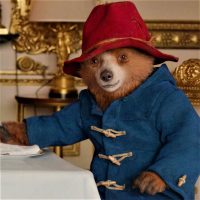 Children’s fiction has been replete with fantastic stories of bears, who transcend their animal status and become actual ‘persons’ who the children can easily relate to.
Children’s fiction has been replete with fantastic stories of bears, who transcend their animal status and become actual ‘persons’ who the children can easily relate to.
Each new generation has grown up on a steady diet of bear tales and handed down the ‘bear’ legacy to their children, and they to their children. So much so that even now, bear stories and characters continue to be among the all-time favourite bedtime stories of children around the world.
What is the world’s oldest Bear Story? HOW THE BEAR LOST ITS TAIL. 中国民间故事
SEE Bears in World Literature and Other Stories
“At sales, every other toy looks simply worn, dilapidated, grubby. A bear looks lost and abandoned and desperately in need of a loving home.” – Helen Thompson
The experienced bear has seen life through the heart and eyes of a child…
“A Teddy bear’s virtue is that he cannot love himself — only others. An experienced Teddy Bear brings with him a lifetime of knowledge and experience. The wisdom of silence and the stillness in moments of great turmoil. The long-suffering patience that is learned when belonging to a child who is coming of age. And coping with the bewilderment that this period of time can bring, is what he does best. The experienced bear has seen life through the heart and eyes of a child grown to adulthood and perhaps even accompanied that adult all the way to the end of the road.” – Ted Menten
For more about the History of Teddy Bears, go to Teddy Bears – Wikipedia.
Teddy Bears in History – How Teddy Bears were Invented.
About the Contributors: Angeline Hope is a collector of life size stuffed animals — you can view a selection of life size stuffed animals at MyBigPlush. Ted Menten ran the magazine Teddy Bear Review (later merged with Teddy Bear & Friends), has written 19 books on that subject and conducts teddy bear-making classes. Devinder Madnani has written articles about health matters, event planning and marketing. Brian Alan Burhoe (AKA Papa Bear) is your genial guide to the Civilized Bears.
==>> SEE Papa Bear’s Blog
